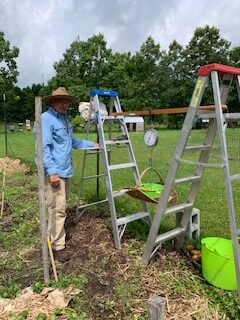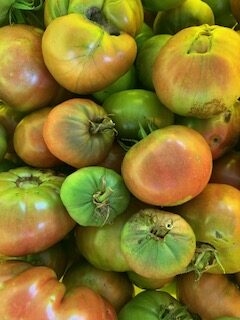JOHNS ISLAND, South Carolina – Applying a green microalga, in combination with compost, to tomato plants appears to improve plant vigor and increase crop yields, according to the results of a one-year Southern Sustainable Agriculture Research and Education (SSARE) Producer Grant.
Farm managers Dale Snyder, Jennifer Wicker and George Taylor of Sweetgrass Garden were interested in exploring the effects of Chlorella vulgaris (green microalga) on the health of tomato plants to help them overcome diseases, mainly bacterial spot and Southern blight.
Chlorella vulgaris has been a subject of study as a biostimulant to promote plant growth and health due to its described role as a stimulant that enhances plant growth and yield, increases soil health, and enhances plant immunity to diseases.

In the Southern SARE Producer Grant (FS21-330), “Does Treatment of Chlorella vulgaris Extend the Life of Tomato Plants to Increase Tomato Sales?”, two tomato varieties (Cherokee Purple and a determinant, BHN 1021) were assigned various algae and mushroom compost treatments to determine soil health, plant vigor and yields. Treatment assignments included no amendment as the control, algae alone, compost alone and an algae/compost combination.
One-year of data indicated that the algae had a positive effect on soil fertility and plant yields.
“Wherever the algae was applied, soil health improved and yields increased,” said Snyder. When algae was added to low fertile soils, tomato yields per plant increased 45 percent. When algae was applied in combination with the mushroom compost, yields per plant increased by 16 percent.
“But for greater plant vigor, plants need those extra nutrients provided by the compost,” said Snyder. A qualitative assessment of vigor (including size, color and foliage thickness), found a 76 percent score out of 100 percent for plant vigor with the combined application of algae and compost. By comparison, compost alone scored 69 percent, algae alone scored 61 percent and the control (no amendments) scored 44 percent.
“The algae and the compost combination is where the magic happens,” said Snyder.
Snyder and Wicker said that the algae was applied as a spray to both the soil within a drip line and directly to the plant foliage at a rate of 50,000 cells per square foot. The algae was cultured and developed into a liquid form on farm site.
Snyder, Wicker and Taylor hope to repeat the trial for another year and then determine the recommended amount of algae that can be applied for maximum crop production results.
Sweetgrass Garden, an organic garden just south of Charleston, saw success with using fish waste compost to enhance the soil organic matter of the area’s sandy loam soils – a project funded by an earlier Southern SARE Producer Grant. Sweetgrass Garden is a charity farm, which donates all of what it grows to charitable food distribution agencies in South Carolina. The diversified farm grows a wide variety of vegetable crops, produces honey, and practices silvopasture, as well as serves as a site for an incubator kitchen and GAP training.
To learn more, visit https://www.facebook.com/sweetgrassgarden/
View Related SARE Grant:
- Does Treatment with Chlorella vulgaris Extend the Life of Tomato Plants to Increase Tomato Sales? (FS21-330)
